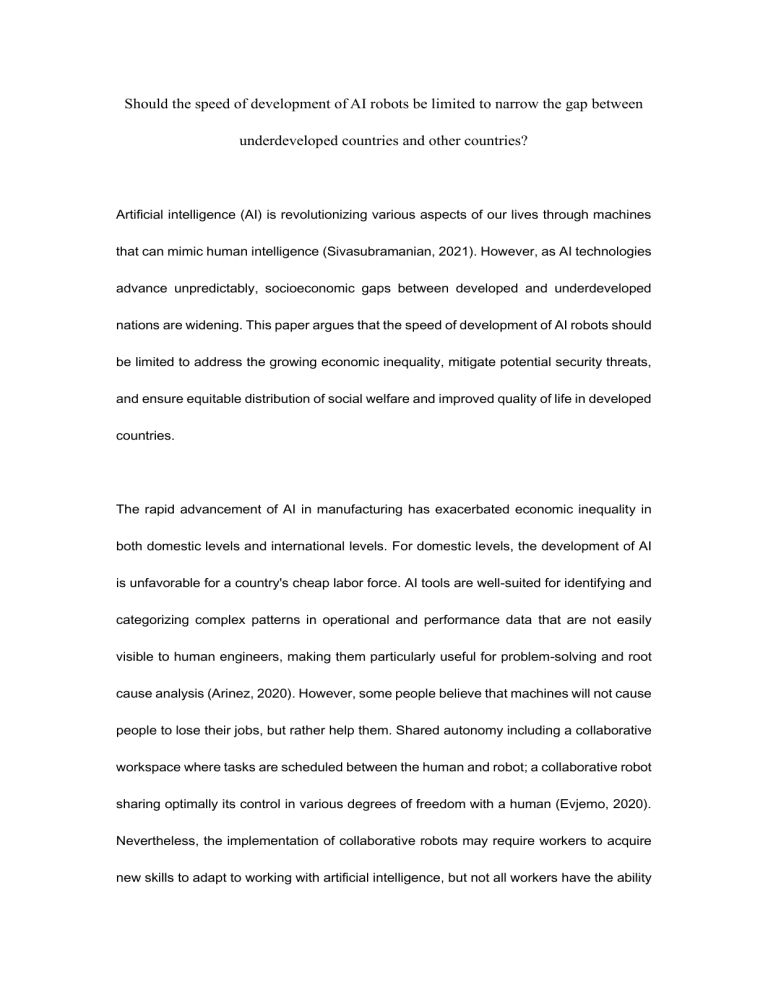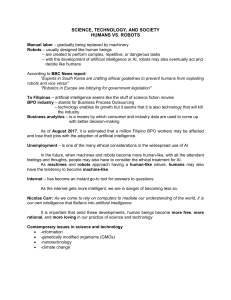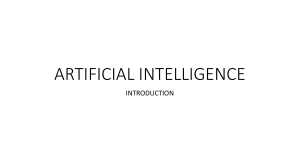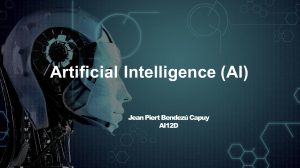
Should the speed of development of AI robots be limited to narrow the gap between underdeveloped countries and other countries? Artificial intelligence (AI) is revolutionizing various aspects of our lives through machines that can mimic human intelligence (Sivasubramanian, 2021). However, as AI technologies advance unpredictably, socioeconomic gaps between developed and underdeveloped nations are widening. This paper argues that the speed of development of AI robots should be limited to address the growing economic inequality, mitigate potential security threats, and ensure equitable distribution of social welfare and improved quality of life in developed countries. The rapid advancement of AI in manufacturing has exacerbated economic inequality in both domestic levels and international levels. For domestic levels, the development of AI is unfavorable for a country's cheap labor force. AI tools are well-suited for identifying and categorizing complex patterns in operational and performance data that are not easily visible to human engineers, making them particularly useful for problem-solving and root cause analysis (Arinez, 2020). However, some people believe that machines will not cause people to lose their jobs, but rather help them. Shared autonomy including a collaborative workspace where tasks are scheduled between the human and robot; a collaborative robot sharing optimally its control in various degrees of freedom with a human (Evjemo, 2020). Nevertheless, the implementation of collaborative robots may require workers to acquire new skills to adapt to working with artificial intelligence, but not all workers have the ability to receive retraining, which may result in a mismatch between the skills required by the constantly evolving job market and those possessed by the workforce. In terms of international levels, for underdeveloped countries, their development in manufacturing will become increasingly disadvantaged, as the vast majority of AI robots are controlled by developing and developed countries. In 2018, China, Japan, South Korea, the USA, and Germany were the top users of industrial robots, accounting for over 70% of the total industrial robots in operation worldwide (Patalas-Maliszewska et al., 2020). Also, countries with low income may not have the necessary skills and infrastructure to actively engage in the developing global value chains, as the significance of low labor costs in determining international competitiveness decreases due to automation (Artuc, 2023). The proliferation of advanced AI robotics among certain countries presents significant security concerns, as these nations may gain a substantial advantage on the battlefield, posing a threat to other countries. Developed states like the US gain military advantages from AI. The U.S. Department of Defense (DOD) is creating AI programs for various military purposes. (Hoadley & Lucas, 2018). In many countries, increasing employment of AI robots has potential uses in applications such as reconnaissance, mine clearance, observation and target acquisition (Doare et al., 2014). These weapons pose a great threat to countries that lack defensive capabilities. Weapons are autonomous in so far as they can locate, select and ‘engage’ human targets without human supervision…it is possible for a million tiny drones equipped with explosives, visual recognition capacity and autonomous navigational ability to be contained within a regular shipping container and programmed to kill en masse without human supervision (Federspiel, 2023). At the same time, the advancements in robotics have the potential to significantly enhance social welfare and improve the quality of life in well-developed countries. In the medical aspect, AI robots can be effectively utilized. In the field of patients and consumers, recent AI applications have adopted a data-centric approach. Online health communities and social media platforms have gained popularity as avenues for individuals to connect and share support (Staccini, 2019). Also, the future evolution of education will be closely intertwined with the progress of AI to a significant extent. Therefore, future education will be further enhanced and enriched by the advancements and innovations of new technologies and the computational capabilities of intelligent machines (Chen et al., 2020). These are all unequal for underdeveloped countries. Nevertheless, the sharing of AI robots can also promote the development of underdeveloped countries. As the world becomes increasingly interconnected, the potential for artificial intelligence and technology to have a positive impact on underdeveloped countries is increasing (Mungoli, 2023). However, for these countries, development means underdevelopment. As Stephen K. Sanderson (2013) summarized Andre Gunder Frank’s opinion: “The term "dependence" refers to an economic system that has already integrated into the operation of another economic system and is causing sustained or potentially increasing damage to underdeveloped partners in some way.” This dependency can limit their ability to develop and control their own technological capabilities, potentially perpetuating a cycle of reliance on external sources for innovation and development. In conclusion, the development speed of artificial intelligence robots should be limited to address the expanding economic inequality, mitigate potential security threats, and ensure fair distribution of social welfare worldwide. Limiting the development speed of artificial intelligence robots is to ensure fairness and stability in global society, and this restriction can ensure that the utilization of artificial intelligence technology is in line with global interests and promotes sustainable development of all nations. Reference List Arinez, J. F., Chang, Q., Gao, R. X., Xu, C., & Zhang, J. (2020) Artificial intelligence in advanced manufacturing: Current status and future outlook. Journal of Manufacturing Science and Engineering, 142(11), pp.1-16. Available at: https://asmedigitalcollection.asme.org/manufacturingscience/article/142/11/110804/10 85487/Artificial-Intelligence-in-Advanced-Manufacturing (Accessed: 11 January 2024). Artuc, E., Bastos, P., Copestake, A., & Rijkers, B. (2022) Robots and trade: Implications for developing countries. Robots and AI, pp. 232-274. Available at: https://asmedigitalcollection.asme.org/manufacturingscience/article/142/11/110804/10 85487/Artificial-Intelligence-in-Advanced-Manufacturing (Accessed: 19 January 2024). Chen, X., Xie, H., Zou, D., & Hwang, G. J. (2020) Application and theory gaps during the rise of artificial intelligence in education. Computers and Education: Artificial Intelligence. Availble at: https://www.sciencedirect.com/science/article/pii/S2666920X20300023 (Accessed: 13 January 2024). Doare, R., Danet, D., & Hanon, J. P. Robots on the battlefield: contemporary issues and implications for the future. United States: Ecoles de Saint-Cyr Coëtquidan. Evjemo, L. D., Gjerstad, T., Grøtli, E. I., & Sziebig, G. (2020). Trends in smart manufacturing: Role of humans and industrial robots in smart factories. Current Robotics Reports, 1, pp.35-41. Available at: https://link.springer.com/article/10.1007/s43154-020-00006-5 (Accessed: 24 January 2024). Federspiel, F., Mitchell, R., Asokan, A., Umana, C., & McCoy, D. (2023). Threats by artificial intelligence to human health and human existence. BMJ global health, 8(5). DOI: 10.1136/bmjgh-2022-010435 (Accessed: 24 January 2024). Hoadley, D. S., & Lucas, N. J. Artificial intelligence and national security. United States: Congressional Research Service. Lau, A. Y. S. & Staccini, P. (2019) Artificial intelligence in health: New opportunities, challenges, and practical implications: Findings from the yearbook 2019 section on education and consumer health informatics. Yearbook of medical informatics, 28(01), pp.174-178. Available at: https://www.thiemeconnect.com/products/ejournals/html/10.1055/s-0039-1677935 (Accessed: 13 January 2024). Mungoli, N. (2023) Leveraging AI and Technology to Address the Challenges of Underdeveloped Countries. Journal of Electrical Electronics Engineering, 2(3), pp.211-216. Available at: https://www.opastpublishers.com/open-accessarticles/leveraging-ai-and-technology-to-address-the-challenges-of-underdevelopedcountries-5806.html (Accessed: 24 January 2024). Patalas-Maliszewska, J., Pająk, I., & Skrzeszewska, M. (2020) AI-based Decision-making Model for the Development of a Manufacturing Company in the context of Industry 4.0. IEEE International Conference on Fuzzy Systems (FUZZ-IEEE), pp. 1-7. Available at: https://ieeexplore.ieee.org/abstract/document/9177749 (Accessed: 12 January 2024). Sanderson, S. K. (2013) Sociological worlds: comparative and historical readings on society. London: Routledge. Sivasubramanian, M. (2021). ARTIFICIAL INTELLIGENCE'S IMPACT ON OUR EVERYDAY LIVES. “Success is no accident. It is hard work, perseverance, learning, studying, sacrifice and most of all, love of what you are doing or learning to do”., 1. Available at: https://www.researchgate.net/profile/RujutaKherdekar/publication/359051296_Advances_in_Artificial_Intelligence/links/6224f8ed a39db062db850cac/Advances-in-Artificial-Intelligence.pdf#page=12 (Accessed: 24 January).



